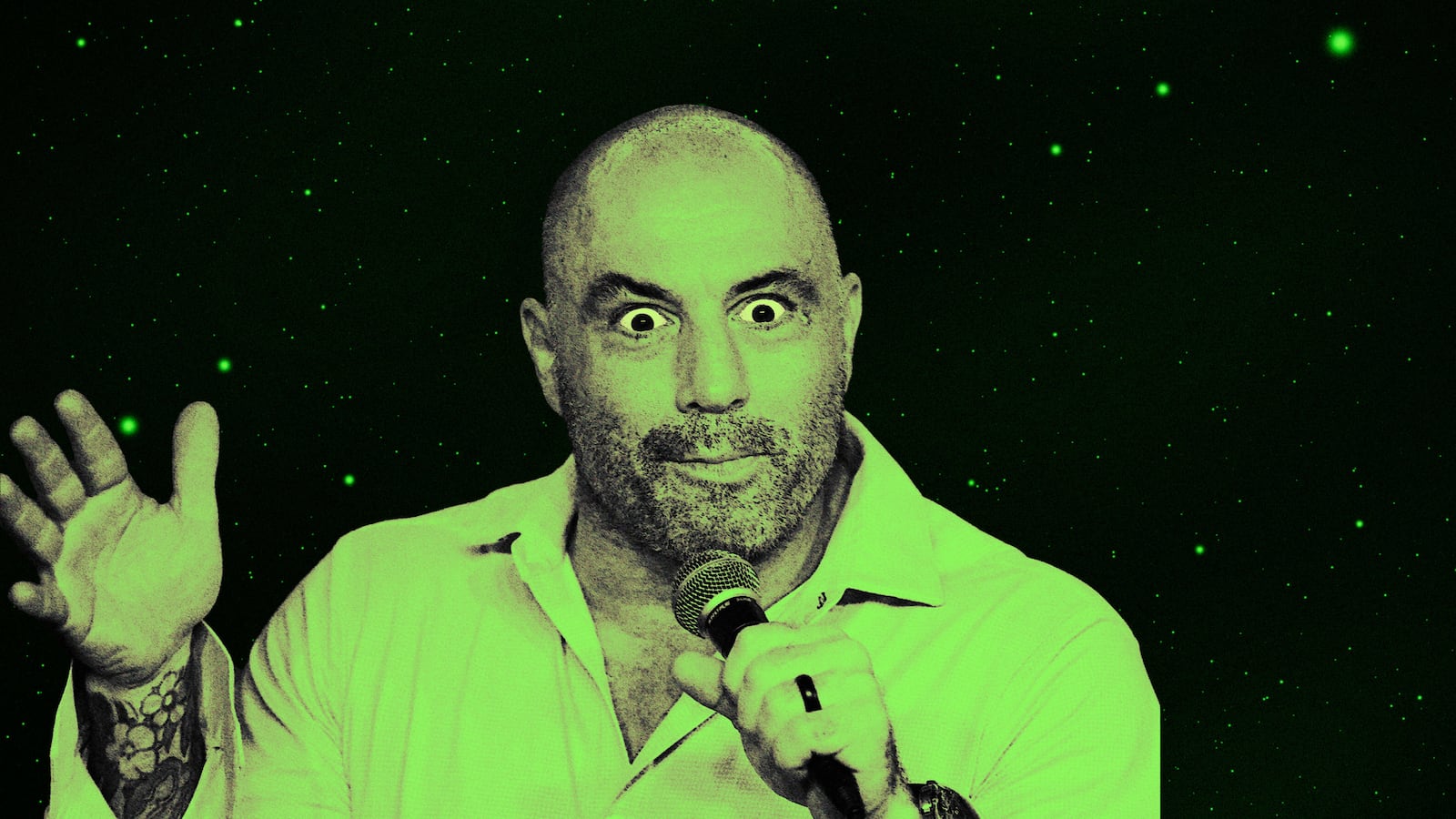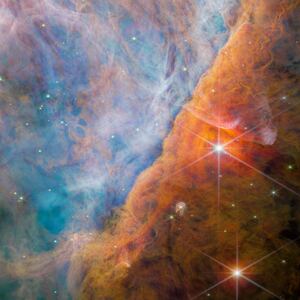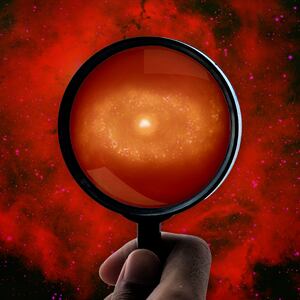Not content to push homophobia, transphobia and fat-shaming, make light of sexual assault, and undermine the public’s confidence in vaccines, uber-popular radio host Joe Rogan is now doing his best to dismantle astronomy, too.
On July 16, Rogan tweeted to his 11 million followers a link to a press release from the University of Ottawa promoting recent research from Rajendra Gupta, one of the school’s adjunct physics professors.
Flouting decades of work by hundreds of the world’s best astronomers and physicists, Gupta invented a new formula, blended it with data from NASA’s James Webb Space Telescope and concluded the universe is 26.7 billions years old.
That’s nearly twice as old as the universe’s actual age—13.7 billion years, a figure scientists spent decades calculating.
Virtually none of Gupta’s peers agree with him, but that didn’t bother Rogan. Nor did it trouble Elon Musk, the billionaire owner of Twitter, who replied to Rogan’s tweet. In addition to Rogan’s signal-boost, USA Today has highlighted Gupta’s old-universe notion, as has Popular Mechanics. A dubious notion from a minor player in the space sciences has gone mainstream.
Gupta is wrong. But he’s just the right kind of wrong that appeals to self-proclaimed “free-thinkers” such as Rogan and Musk. With an assist from some mainstream media, the two libertarians are, wittingly or unwittingly, chipping away at one of the last bastions of pure science—the space sciences. Which is especially ironic considering that Musk also owns a rocket company.
The populist embrace of Gupta’s fringe idea could have dangerous implications. “Misinformed voices who lack credentials can drown out the educated voices who have spent their lives studying a subject,” Allison Kirkpatrick, a University of Kansas astronomer, told The Daily Beast.
Gupta’s main mistake was to revive a discredited theory about light. Space scientists agree that light tends to change color across time and space. Since the universe is expanding, light—in order to keep up—tends to stretch out as it radiates. Over billions upon billions of miles and millions of years, this stretching-out changes the light’s wavelength and makes it more red.
This so-called “redshift” is extremely useful to Earthbound astronomers gazing out at the inky depths of the cosmos. Exactly how red a star, or a galaxy full of stars, appears to be can tell us how far away it is, and—as the universe is expanding—how old it is.
Since everything in the universe started out in the same spot, and then burst outward with the Big Bang, the oldest and reddest observable objects should be close to the overall age of the universe. At the same time, this age should align with the gradual decay of the background radiation from the Big Bang.
Match up these and other observations, as many scientists have done many times, and you get roughly the same age for the universe: 13.7 billion years.
But Gupta was unhappy with the number, as he fixated on new data about some very old galaxies that are only now becoming observable thanks to the $10-billion James Webb Space Telescope, which launched on Christmas Day in 2021.
Some of the oldest observable galaxies seem to have developed weirdly quickly in the first few hundreds of millions of years after the Big Bang. “The well-accepted standard model of the universe is in tension with the JWST data,” Gupta told The Daily Beast.
So Gupta tried something new. He mixed into his calculations the defunct “tired light” model, which assumes the universe isn’t expanding—and that any redshift we observe comes from light literally wearing out and stretching out over time. He then applied tired light to an expanding universe.
The result is a description of a very old universe. One that’s expanding and is filled with light that slows down all on its own across space and time. The implication for astronomers, if Gupta’s model actually worked, is that those ancient and faraway galaxies wouldn’t be 13.7 billion years old. They’d be 26.7 billion years old.
Those extra 13 billion years would have given the oldest galaxies—the ones that recently became visible through the JWST—ample time to evolve. “The hybrid model is found to be compliant with the JWST observations,” Gupta said.
It’s all very tidy. But only if you ignore a lot of other data, including the observable decay in the cosmic background radiation from the beginning of the universe.
Also, the tired-light model should make faraway galaxies lose focus from our point of view here on Earth. “Distant galaxies would appear blurred if tired light were correct, but they do not,” Brian Keating, an astrophysicist at the University of California, San Diego, told The Daily Beast.
The bottom line is that Gupta’s theory doesn’t work. Yes, we still have a lot to learn about the oldest galaxies and how they seemingly formed so quickly. No, those mysteries do not fundamentally rewrite overlapping models that have aligned in recent decades to tell us that the universe is 13.7 billion years old.
In the sciences, it’s OK to be wrong—as long as you work in good faith, submit your data and findings to your peers, accept their scrutiny, correct your mistakes and move forward with a better understanding while others publish rebuttals of your original work. This is peer review, writ large, and it’s essential.
The problem is the media, which can short-circuit the slow process of peer review—and tempt unscrupulous or impatient academics to do the same. “Media outlets seek compelling and attention-grabbing stories, while academic institutions and researchers strive for visibility and recognition for their work,” Keating explained. “As a result, there can be a temptation for both parties to exaggerate findings, oversimplify complex research or present preliminary results as definitive conclusions.”
For his part, Gupta said he’s “not worried.” “My theory is in the open for people to test and criticize.” But the qualified critics of Gupta’s work don’t have nearly the reach that the populist boosters do. Combined, Rogan and Musk can instantly reach tens of millions of attentive followers. In this case, they may have seeded in millions of minds the incorrect notion that the universe is twice as old as it actually is.
To be fair, the age of the universe doesn’t have much direct bearing on how most of us live our lives. But science in general does have a direct bearing on our lives—and science says the universe is 13.7 billion years old, not 26.7 billion years.
“If we can't convince people to trust science about things that have very little impact on their lives,” Kirkpatrick asked, “how can we convince them to trust scientists on the most important questions facing humanity?” The safety and effectiveness of vaccines, for instance. Or the urgency of climate change.
“Astronomers used to be one of the most trusted scientific professions because we don't have any obvious agendas,” Kirkpatrick said. “We are not being paid by corporations. But now we're being questioned on things like the age of the universe.”









